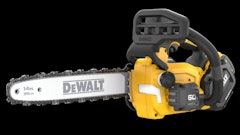
As landscaping fleets consider making the shift to EVs, they're faced with a wealth of conflicting information on the cost-effectiveness of these assets—both in fueling and upkeep. While some reports suggest that EVs are more expensive to run per 100 miles compared to traditional internal combustion engine (ICE) vehicles, others argue that EV charging still represents good value.
Anderson Economic Group's findings indicate that EV charging costs have outpaced the price of fueling ICE vehicles, raising concerns about the economic viability of EVs. Similarly, energy analyst Bill Cinnamon warns of escalating charging costs. Conversely, RAC EV spokesperson Simon Williams and Inside EVs emphasize the continued value proposition of charging EVs compared to filling up conventional vehicles. The prevalence of conflicting reporting underscores the challenges businesses face as they seek clarity on the true cost of adopting EVs.
Before jumping into EV procurement willy-nilly, it’s best to perform a cost analysis. Analyzing the potential cost and comparing it to similar conventional fuel vehicles can help fleets make informed electrification decisions that align with their operational and financial objectives, as well as emissions regulations.
Notable concerns
While the primary concerns of EV adoption are typically upfront cost and range anxiety, there are additional factors to consider, one of which is emissions regulations. As Illinois goes the way of California with stringent EV regulations, for example, consumers, including fleets, will potentially be prohibited from purchasing choices that align with operational needs.
Additionally, not much headway has been made on bolstering the charging infrastructure. Two years after Congress agreed to spend $7.5 billion on EV charging nationwide, there’s yet to be much accomplished. On top of that, electricity prices have risen consistently over the past three years, making the touted major benefit of fueling cost reduction not as big a selling point, especially when factoring in repair costs, as maintaining EVs can rack up a bigger bill than ICE counterparts.
Procurement strategy and cost
When planning for EV adoption, there’s a lot of ground to cover. One major question is around charging schedules. While slow charging is optimal, it would need to be done during off hours due to the length of time it takes. Consistently fast charging EVs degrades the battery faster, but would likely be necessary occasionally. Also, due to the weight of EVs, tires and brakes wear faster than those on comparable ICE vehicles, so avoiding stop and go traffic and poor road conditions can go a long way in preserving asset health. Initial EV adoption planning should take all these factors into consideration to ensure maximum return on investment (ROI).
Once a solid plan is in place, it’s time to move on to asset-specific cost analysis. This is a great way to assess the feasibility of EV adoption and help determine which EV makes the most sense for the fleet. Cost analysis should include:
- Capital costs
- Insurance
- Rebates and tax credits
- Maintenance and repair expenses
- Charging costs and duration
- Charging infrastructure costs (if applicable)
While fleets can gain a comprehensive understanding of the financial implications of transitioning to EVs through cost analysis, it’s important to note that the accuracy of those analyses hinges on reliable data.
Going beyond manufacturer-provided asset details and leveraging the experiences of industry professionals and peers already running EVs can further give fleets a better idea of EV performance. Networking opportunities at industry conferences and trade shows offer valuable forums for exchanging insights and best practices, enabling fleets to refine their cost analysis estimates based on real-world experiences.
Simplifying cost analysis
Because effective cost analysis requires the interaction of many data points, it can be a cumbersome task when done manually. Fleet solutions like fleet management software (FMS) simplify cost analysis and ensure clean data by automating data collection, consolidation, and aggregation. Plus, FMS allows landscaping fleets to integrate other fleet and business solutions so all data is consolidated on a single platform with a customizable dashboard. With features tailored to EV fleet management, FMS enables fleets to track and monitor key metrics, such as charging costs and duration, vehicle performance and total cost of ownership, in real time.
Of course, without an EV in the fleet, pulling EV data for cost analysis would be rather challenging. This is where it helps to have input from industry peers running EVs. Fleets can create a dummy EV profile in FMS and populate it with manufacturer-provided details. From there, add in charging costs for the area of operation, and use insights gained from peers to make adjustments.
With the amount of conflicting information surrounding fleet electrification, relying on robust cost analysis and data-driven insights can help fleets make informed decisions around EV adoption.


























